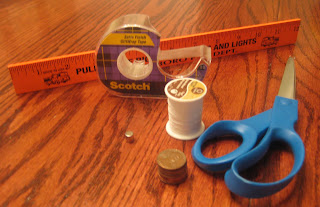
LittleBit and Dad did another magnet experiment. LittleBit thinks magnets are very interesting. They used the motor generator kit again for this experiment. The materials used were: tape, magnet (rare earth magnet used but can be any decently strong magnet), string/thread, ruler, and pennies (enough to stack under magnet without touching.

Previous experiments had identified that not all metal objects are attracted to magnets. This experiment shows how non magnetic metal objects can interact with magnets.
Steps:
1) Verify that magnets and pennies do not attract.
2) Attach magnet to string with tape and suspend magnet above table (clearance to table ~ 1 inch) . Alternative: tape string to edge of table and suspend magnet above floor

3) Place ruler on table as a reference point for the magnets home position (our home position was the 6 inch mark)
4) Pull magnet to one side by an inch (5 for us), let go of magnet and count the # of times it passes your home position (#6) and record result.
5) Do the same for 2 inches (4 inch mark) and record result.
6) With the magnet at rest, place as many pennies beneath magnet as possible (6 inch position). Make sure tape and magnet do not touch the pennies.
7) Repeat steps 4 and 5 making sure magnet swings over pennies. Got a big “Wow” out of LittleBit when he saw the difference. He was also in charge of “swinging” the magnet and recording the results.

What happened?
The number of times the magnet passed the home position was less with the pennies than without them. As the magnet moved past the pennies it caused movement of electrons in the pennies (otherwise known as eddy currents, real small electric current)). The effort it takes to move the electrons slows the magnet and reduces the number of times it passes the home position. I told LittleBit that the magnet caused the electrons inside the pennies to move. We could not see them move because they are so small. Also we discussed the real world applications such as, roller coaster brakes, and brakes for “bullet” trains.
Aluminum foil and other non-magnetic metals will also work for this experiment.

No comments:
Post a Comment